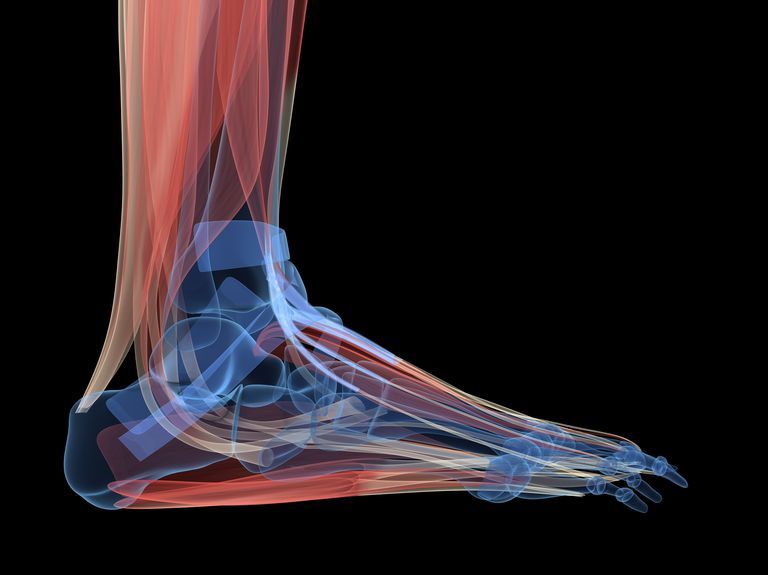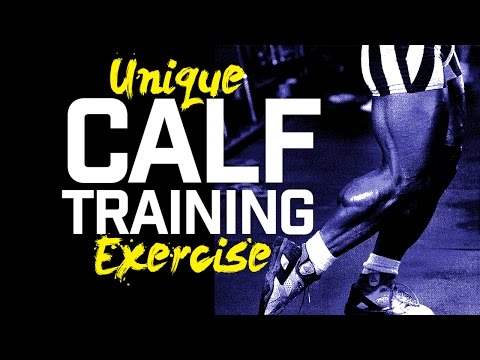WHETHER YOU LOVE to rep out heavy squats, box jump your way through a CrossFit class, or run like the wind, a major key for your workout success will be ankle strength and stability.
Workouts aside, being steady on your feet is important—even if your main goal is just getting your steps in and staying active. The ankles are the connection point from your legs to your feet, and if they’re not in great condition, your aptitude for locomotion (in plain English, your ability to move around) will suffer. Regardless of your exercise preference, you’ll want to do your best to keep your ankles in tip top shape.
Taking the time to give this important joint a little love is well worth the time and effort. Weak ankles can contribute to a number of injuries, like sprains, torn ligaments or tendons, broken bones, and even shin splints. If you’ve experienced any of these, you already know how painful they can be can be. Plus, ankle injuries almost always mean trouble walking, which can cause a serious loss of normal functioning.
Prevent these issues by saving a little time at the beginning or end of your workout for some focused ankle training. There are several exercises and stretches that you can program into your day that take minimal time to maximize your joint health. It’s called proprioception training, and it can help the mind better connect to the muscles.
It’s important to remember that these exercises shouldn’t hurt. If any movements are causing pain, or if you think you have a previous injury, it’s best to see a medical professional, like a primary care doctor or physical therapist.
Benefits of Strengthening Your Ankles
The ankle joints and the muscles that move them aren’t only essential in that they connect your feet to your legs; they’re also an important mechanism for your overall ability to walk, jump, and more. And if they’re not in great shape, you won’t be either. Weak, wobbly ankles are often a precursor to more serious issues, so making sure that you train them to build strength can help to prevent injuries.
What is Proprioception?
You can strengthen the muscles in and around your ankles all you want, but if you lack good proprioception, your ankle strength isn’t going to help you. Proprioception is perception or awareness of your body’s position and movement in space. Basically, it’s your brain’s ability to orient yourself in space.
There is a feedback loop between your peripheral nervous system (particularly sensory receptors) and your brain that helps your brain send the quick signals it needs to help you stabilize long before you have had time to make a conscious decision about which muscles to activate. So, for better ankle stability, you’ll want to bolster both systems—the neuromuscular and the musculoskeletal systems.
The Muscles of the Ankle
There are many muscles that cross the ankle joint, including the gastrocnemius, soleus, posterior tibialis, flexor hallucis longus, and peroneal longis and brevis. You’ll want to strengthen these muscles in a few different ways. Each muscle contributes to both moving your ankle and stabilizing the ankle joint.
When muscles on one side of the joint contract or shorten, the ankle moves in that direction, simultaneously lengthening the muscles on the opposite side. When you want to stay still, instead of none of the muscles being active, you want multiple muscles to work together, or “co-contract” preventing movement in multiple directions at the same time.
Many of the strengthening exercises for the ankle focus on ankle stability, which is important for any running or jumping sport, as well as daily function. But ankle stability doesn’t just come from your muscles—it also comes from your brain. This is where proprioception matters By practicing these drills, you can help your brain know how and when to stabilize the ankle joint, and support that system with stronger ankle muscles.
Check out this list of ankle exercises that target both the muscles in and around the joint, as well as the system that helps activate them when you need them most.
11 Ankle Strengthening Exercises
Single-Leg Lateral Jumps
2 rounds of 60 seconds
Single-leg lateral jumps are a great way to improve your athleticism and balance. These exercises “develop the ability to explosively move side to side, while training both the tendons and proprioceptive system to land in a stable and safe position,” says Brett Warner, DPT, C.S.C.S., of Bespoke Treatments. Remember to land in a partial squat position to protect the knee, and hold until you are fully stabilized, Warner says. Try this out for 2 rounds of 60 seconds a piece, making sure you alternate legs on each round.
Single-Leg Balance with Rotation
2 rounds of 60 seconds
Proper ankle balance means training in all planes of motion; it’s not enough to just balance on one foot, perfectly still.
With this movement, balance on one foot and bring the opposite knee up to hip height. When you’re stable, slowly start rotating the knee out towards the side of the body. “Adding trunk and hip rotation to single leg balance trains the ankle to maintain a stable base while twisting or rotating, such as direction changes on the field or court,” says Warner. He recommends doing 2 rounds of 60 seconds a piece, alternating legs on each round.
Eccentric Dorsiflexion
3 rounds of 15 reps
Dorsiflexion is what allows you to pull your toes up towards your shin. It’s a vital ankle movement. Even though it sounds super basic, training something as simple as dorsiflexion can help improve endurance for running, sprinting, or other sports. It can even help prevent shin splints, says Warner.
To do this move, sit in a chair with your feet propped up on a stool or bumper plate if you’re doing this in the gym. Let the forefoot dangle off the edge. Slowly lower the toes down towards the ground for 5 seconds, and then lift the toes back up towards the shins for a count of 2 seconds. You can always add some resistance to this move by holding a resistance band or light kettlebell over the forefoot. Warner suggests doing this for 3 rounds of 15 reps on each side.
Standing Heel Raises
Two up, two down
Stand at a kitchen counter or table so that you can lightly touch the surface for stability. Begin standing normally, with feel hip width apart. Slowly lift up your heels by going up on your toes. Slowly lower yourself back down with control (don’t just drop).
Be sure to stay in control of the movement and go all the way onto your toes as long as this movement is pain free. Try not to let your ankles roll as you do this. Repeat for 2 to 3 sets of 10. Stretch your calves afterwards.
Standing Heel Raises With Single-Leg Eccentric
Two up, one down
This variation of heel raises is slightly more challenging. Begin the same way, going up onto your toes. Then, instead of lowering down both heels at the same time, remove one foot so that you are standing on the toes of one foot and lower down only with that one foot.
Repeat by going up with both feet, then down with one again. Do this 10 times on one side, then 10 times on the other side.
Single-Leg Balance on an Unstable Surface
One of the best ways to improve ankle stability is to challenge the ankle’s stability. Try using an Airex or any other type of dense foam or slightly squishy surface. Simply stand on one foot and try to balance for at least 30 seconds. If your ankle is wobbling all over the place or if you cannot maintain your balance for more than 5 seconds, you might not be ready for this exercise.
If 30 seconds on one foot is easy, try a softer surface or using the round side of a BOSU ball and add throwing a ball up and down in place if you’re alone, or playing catch with a friend if someone else is around. Still easy? Use a weighted ball and have your friend throw it to each side of you so that you throw off your center of gravity.
Resisted Ankle Eversion and Inversion
This exercise requires a resistance band. Tie a small loop at the end of a 3-foot elastic resistance band. Loop your foot into the hole. Begin by placing the center of the loop around the base of the big toe. Wrap the band so that you create a line of pull perpendicular to your leg from that point.
Begin with the foot rotated toward the little toe. Then, slowly move your foot out towards the big toe against the resistance without moving your knee. Gently return foot to starting position with control —do not let the band whip it back. Repeat with the band set up the opposite way—with the loop around the base of the little toe and the band anchored to the opposite side. Perform 10 to 15 reps of each.
Star Exercise
Stand in one place and set up cones in a “star” formation, with 5 cones in a circle around you. While balancing on one foot, tap each cone gently as you make your way around the “star.”
Note: one cone will require you to reach diagonally behind you and another will require you to reach diagonally in front of the leg your balancing on. Repeat the cycle 5 times. If it’s easy, try it standing on a squishy or unstable surface like an Airex foam pad or a BOSU.
Squat Jumps
The gastrocnemius and soleus muscles are key muscles for propulsion and power. They act like a wound-up spring storing kinetic energy that, when release, creates an elastic energy to propel you into the air.
Squat jumps are a great exercise to strengthen these muscles while also strengthening the glutes, quads and hamstrings. To perform, begin in a standing position with feet hip width apart. Slowly lower down to the ground before jumping straight up. Continue to jump straight up pushing off of your toes while squatting between each jump.
Squats on Balance Board
Whether you’re riding public transit or just standing on an uneven surface, try adding a dynamic component to your balance drill to increase the challenge.
To perform, stand on a balance board or wobble board with one fulcrum of movement (medial to lateral or anterior to posterior). Bend your knees slightly to try and find stability, then perform 10 squats without letting either edge of the board touch the ground.
Soleus Presses
This content is imported from youTube. You may be able to find the same content in another format, or you may be able to find more information, at their web site.
The soleus is a broad, flat muscle under the perky gastrocnemius that is key in walking, running, balancing and jumping. To strengthen the soleus, try soleus presses. Sit with your knees bent, toes on a Smith machine bar and weight over your knees. With your toes in contact with the floor, slowly lift your heels pressing up onto your toes. Then slowly lower back down. Control is key. Perform these until fatigue.
Dr Rachel Tavel, PT, DPT, CSCS is a Doctor of Physical Therapy, Certified Strength & Conditioning Specialist, health and fitness writer, and runner who works as a PT at Shift Wellness in New York City.
Cori Ritchey, NASM-CPT is an Associate Health & Fitness Editor at Men’s Health and a certified personal trainer and group fitness instructor. You can find more of her work in HealthCentral, Livestrong, Self, and others.






Comments are closed.